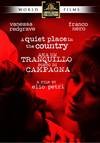| Reviews & Columns |
|
Reviews DVD TV on DVD Blu-ray 4K UHD International DVDs In Theaters Reviews by Studio Video Games Features Collector Series DVDs Easter Egg Database Interviews DVD Talk Radio Feature Articles Columns Anime Talk DVD Savant Horror DVDs The M.O.D. Squad Art House HD Talk Silent DVD
|
DVD Talk Forum |
|
|
| Resources |
|
DVD Price Search Customer Service #'s RCE Info Links |
|
Columns
|
|
|
Quiet Place in the Country (Un Tranquillo Posto di Campagna), A
Brilliant psychological/supernatural horror movie. M-G-M and 20th Century-Fox, through their own M.O.D. (manufactured on demand) service, the M-G-M Limited Edition Collection, has released A Quiet Place in the Country (Un Tranquillo Posto di Campagna), the 1969 Italian-French shocker starring Vanessa Redgrave and Franco Nero, directed by Elio Petri (it appears here under a new banner for the Limited Edition Collection: World Films). A sensuous, scary, horrifying nightmare of artistic madness...or supernatural possession (?), A Quiet Place in the Country was totally new to me―and it blew me away. An original trailer is included for this beautiful widescreen transfer, but don't be mislead by the back cover of M-G-M's disc holder: A Quiet Place in the Country is presented here in its original Italian language track with optional English subtitles, as M-G-M states...but the original English dub is also available on the disc, too―very cool.
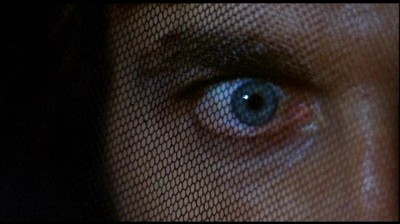
Leonardo Ferri (Franco Nero), is one of the top young avante garde painters in Milan, Italy...and he's quickly going crazy there; he hasn't completed a painting in two months. Threatened by his agent/lover Flavia (Vanessa Redgrave), who's insistent on keeping the touchy, mercurial artist productive while he's still the flavor of the month, Leonardo accepts an offer to work at a count's villa. However, upon arrival, he freaks out and leaves (the Count and Flavia made too big a deal of the arrangement, including inviting the press), being drawn to a crumbling, abandoned villa farther out in the country. Insisting that Flavia purchase the villa for him, Leonardo discovers from the property's caretaker, Attilio (Georges Geret), that the former owner, killed in an RAF air raid during WWII, was a young countess who was vilified by the townspeople for being sexually promiscuous. Quickly becoming obsessed with finding out who this woman was, Leonardo begins to lose his grip on reality...or is he being tormented by the young countess' ghost?
MAJOR MOVIE-RUINING PLOT SPOILERS WARNING!
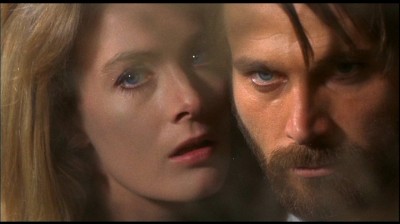
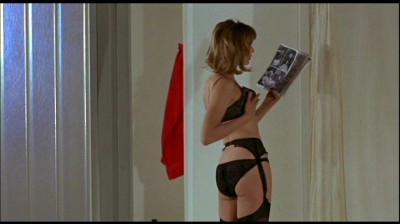
Prior to this disc showing up in my mailbox, A Quiet Place in the Country would have been just another title in director Elio Petri's list of films to me. Petri's The 10th Victim is a yearly favorite of mine, and Investigation of a Citizen Above Suspicion impressed me when I saw it back in college, but A Quiet Place in the Country was completely new to me (I didn't even know who starred in it until I saw the DVD cover). How cool, then, is it to find the kind of movie that hits all the marks for you―1960s European filmmaking, big international stars, a glossy, dazzling visual approach to sex and violence―when you never even heard of it before? That kind of discovery is exactly what the studios' M.O.D. library services should be about: little-seen titles that need to be more readily available.
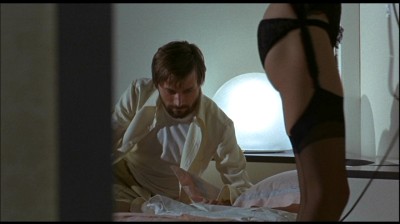
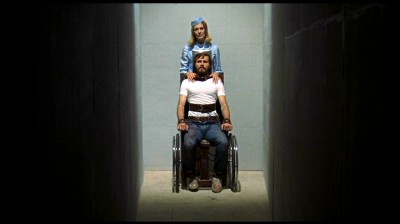
Whether or not you take A Quiet Place in the Country as a ghost story or a psychological horror story (or a combo of the two) is entirely up to you, because director and co-writer Petri, along with scripter Luciano Vincenzoni (The Good, the Bad, and the Ugly, Duck, You Sucker) let you know right up front that A Quiet Place in the Country is going to be more of a self-reflexive commentary rather than a straight-ahead story―not a surprise from this ideas-focused director. With the credits rolling over superimposed splices, scratches and film leader tags, the opening shot of Nero, strapped to a chair, goes to close-up when Vincenzoni blatantly switches the rotating camera lens. That all looks very 60s European "film trendy" now, but it's also the equivalent of having a title card say, "Once upon a time..." It's fantasy. Everything is suspect in A Quiet Place in the Country because not only is the lead character obviously delusion, the director also remains resolutely deceptive and illusionary.
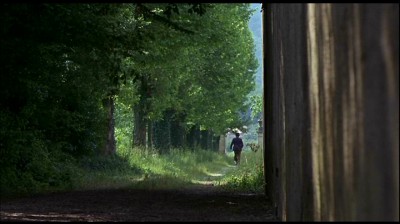
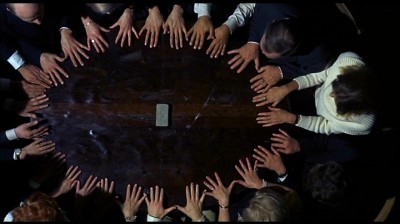
It isn't hard to get at the ideas Petri and Vincenzoni are throwing around here; they're fairly straightforward in their musings about artistic alienation and specifically emasculation in 1969's increasingly mechanized, electronicized western world. The opening sequence, which we learn is really a dream (or is it...), makes its point pretty clearly. Artist Nero, almost naked, is strapped down to a chair, unable to move, when his agent/lover Redgrave comes in from shopping, having bought several pointless gadgets ("a submarine television for scuba diving"). She plugs in all the appliances at his feet, turns them on, and then takes off her panties to turn him on, before he breaks free and tries to kill her―before she knifes him over and over again in the tub...with her clothes off...and then on again. Later, Nero has a vision (?) of Redgrave as nurse, wheeling him around, incapacitated, through the streets, after she's bought some more expensive items (no doubt from the commission she obtains from the paintings she keeps prodding him to execute). None of this is too terribly hard to get at, but it's presented within the framework of Nero being a schizophrenic (and later possibly haunted by a real/unreal ghost), so we're constantly kept off guard by the flashforwards and delusions as to Petri's intentions: message, or story.
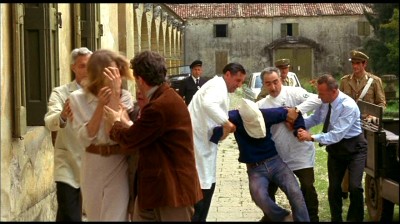
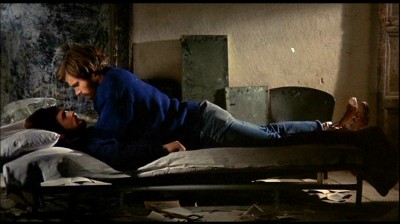
Another theme Petri explores here is the connection between pornography and violence. Having bought soft-core nudie mags (Petri has the magazines "announce" themselves over the soundtrack, as if they're running through Nero's head), Nero heads to bed and reads the stories in an exaggerated, dramatic voice, scorning them (while at the same time, obviously, enjoying the pictures), while Redgrave joins in, eventually becoming turned on herself―which immediately disgusts Nero (which really shows he's crazy, because Redgrave looks incredible here in her black lingerie). When Nero needs to get jacked-up to work (after his recounted dream is laughed at by Redgrave before she orders him to paint again, like an employee or a little boy), he looks at alternating slides of naked women and war atrocities (one assumes they're from Vietnam). And when he does make love to Redgrave, it becomes a parody of what he sees in the books, roughly pushing her face away and choking her. He's angry at her for turning him into a commodity (he states he doesn't work for profits when she insists she needs a certain number of paintings from him); he's turned on by the pornography he looks at, and he's terrified of her sexual hold over him that has contributed to his artistic indecisiveness. The movie's early sequence showing Nero painting (big, wet, red messy paintings, full of water/sexual symbolism that he constantly paints over in indecision) is brilliant, showing inspiration running afoul of artistic frustration and almost certainly madness (Petri is smart enough to keep this all in perspective, though; later in the movie, when someone compliments Nero on his paintings illustrating the "crisis of humans," he sarcastically rejoins they illustrate the crisis of "horse turds").
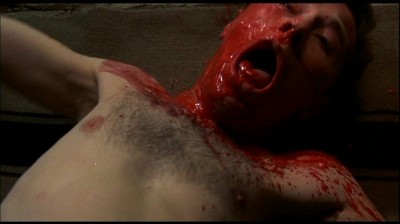
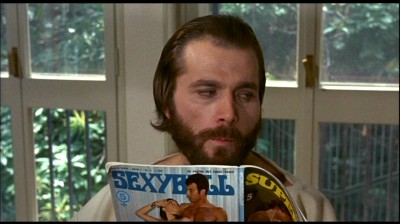
Once Nero takes up residence at the crumbling villa, and becomes obsessed with the story of its former occupant, the ghost story elements of A Quiet Place in the Country kick in through several remarkable sequences where Petri, with the aid of cinematographer Luigi Kuveiller, editor Ruggero Mastroianni, and Ennio Morricone's discordant, chaotic score, thoroughly discombobulate the viewer as to whether or not a ghost is haunting Nero, or if he's imagining it all in his delusional sickness. Again, reality and illusion are indistinguishable from each other here. At one point, it seems certain that some entity has spilled Nero's paints and made a complete mess of his workroom...but at the brilliantly-staged séance scene towards the end of the film, it seems certain Nero was behind all of the ghostly occurrences after all (Nero walks the line perfectly here between sympathetic, sick artist, and possessed lunatic).
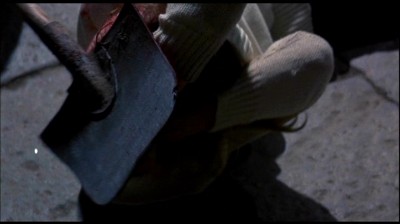
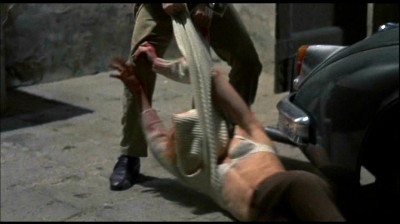
Petri even goes so far as to shoot the entire final act as if he's concretely saying everything is in Nero's head (Petri shows Nero making love to the ghost of the countessa, before he jump cuts to Nero making love to no one...and then himself!), right down to the "imagined" slaying of Redgrave, an absolutely horrifying, nauseating sequence that reminds one of the Manson killings in its savage brutality (Nero, bearded like Manson, flails away at Redgrave with a shovel, bonging her repeatedly in the face―looks quite real―before he drags her lifeless body onto the kitchen table and chops it up for the Frigidaire®). However, the next morning, Nero finds her quite alive as the cops come (first for the caretaker, before Nero, in a nice bit of Hitchcockian suspense and misdirection), ready to lock him up in the nut house. As he paints away, satisfying his orderly's request for small, little paintings in exchange for nudie mags, we see Redgrave collecting the paintings from the orderly, and commenting positively on Nero's work (another jab at modern commerce versus artistic freedom). Did the ghost push him over the edge, or did he do it himself? Was there a ghost? Did he really murder Redgrave, or imagine it? Maybe he's been in the asylum the entire time, and this is all just another fevered delusion, like the opening dream sequence? It all depends on how you look at it....
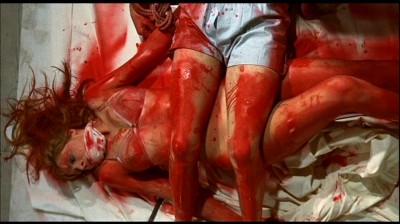
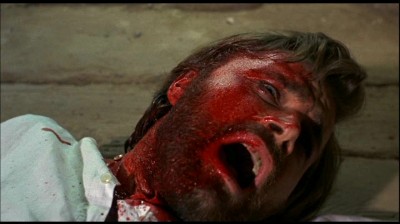
The DVD:
The Video:
The anamorphically enhanced, 1.85:1 widescreen image for A Quiet Place in the Country looks quite good, with solid color, a sharpish image, and only minor dirt and scratches.
The Audio:
The Dolby Digital English 2.0 mono audio track is re-recorded at a high level, with all dialogue quite clear and sharp. Again: don't let the back of the DVD cover fool you―both the original Italian language track and the English dub are available here, both with English subtitles. Very nice for one of these M.O.D. presentations.
The Extras:
There's an original trailer for A Quiet Place in the Country. It's just as creepy as the movie.
Final Thoughts:
Disturbing, sensational aural/visual experience. Writer/director Elio Petri creates a completely unstable environment for his tale of personal madness, artistic chaos, and supernatural violence. Vanessa Redgrave and Franco Nero are beautiful to look at here. One of a kind. On content alone, I'm giving A Quiet Place in the Country our highest rating here at DVDTalk: the DVD Talk Collector Series award.
Paul Mavis is an internationally published film and television historian, a member of the Online Film Critics Society, and the author of The Espionage Filmography.


|
| Popular Reviews |
| Sponsored Links |
|
|
| Sponsored Links |
|
|
| Release List | Reviews | Shop | Newsletter | Forum | DVD Giveaways | Blu-Ray | Advertise |
|
Copyright 2024 DVDTalk.com All Rights Reserved. Legal Info, Privacy Policy, Terms of Use,
Manage Preferences,
Your Privacy Choices | |||||||









